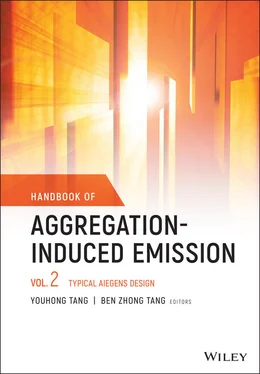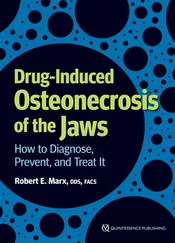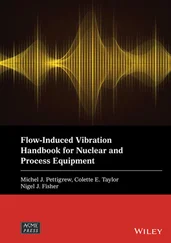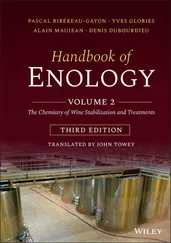Leijing LiuState Key Laboratory for Supramolecular Structure and Materials Jilin University, Changchun Jilin, China
Yali LiuState Key Laboratory of Luminescent Materials and Devices Guangdong Provincial Key Laboratory of Luminescence from Molecular Aggregates Center for Aggregation‐Induced Emission South China University of Technology Guangzhou, China
Elena LucentiInstitute of Sciences and Chemical Technologies “Giulio Natta” (SCITEC) of CNR Milan, Italy
Xiang MaKey Laboratory for Advanced Materials and Institute of Fine Chemicals East China University of Science & Technology Shanghai, China
Niranjan MeherDepartment of Chemistry Indian Institute of Technology Guwahati, Guwahati, Assam, India
Vishal G. MoreSchool of Chemical Sciences Goa University, Taleigao Plateau Goa, India
Andrea PrevitaliDepartment of Chemistry Università degli Studi di Milano Milan, Italy
Anjun QinState Key Laboratory of Luminescent Materials and Devices Guangdong Provincial Key Laboratory of Luminescence from Molecular Aggregates Center for Aggregation‐Induced Emission South China University of Technology Guangzhou, China
T. P. RadhakrishnanSchool of Chemistry University of Hyderabad Hyderabad, India
Bibhisan RoyFaculty of Chemistry (Organic Chemistry) University of Duisburg‐Essen Essen, Germany
Xueliang ShiShanghai Key Laboratory of Green Chemistry and Chemical Processes School of Chemistry and Molecular Engineering East China Normal University Shanghai, P. R. China
N. SenthilnathanSchool of Chemistry University of Hyderabad Hyderabad, India
Siyu SunKey Laboratory for Advanced Materials and Institute of Fine Chemicals East China University of Science & Technology Shanghai, China
Kazuo TanakaDepartment of Polymer Chemistry Graduate School of Engineering Kyoto University Katsura, Kyoto, Japan
Ben Zhong TangState Key Laboratory of Luminescent Materials and Devices Guangdong Provincial Key Laboratory of Luminescence from Molecular Aggregates Center for Aggregation‐Induced Emission South China University of Technology Guangzhou, China Shenzhen Institute of Aggregate Science and Technology School of Science and Engineering The Chinese University of Hong Kong Shenzhen Guangdong, China Department of Chemistry Hong Kong Branch of Chinese National Engineering Research Center for Tissue Restoration and Reconstruction The Hong Kong University of Science & Technology Clear Water Bay, Kowloon Hong Kong, China
Wenjing TianState Key Laboratory for Supramolecular Structure and Materials Jilin University, Changchun Jilin, China
Aijun TongDepartment of Chemistry Tsinghua University Beijing, China
Jens VoskuhlFaculty of Chemistry (Organic Chemistry) University of Duisburg‐Essen Essen, Germany
Zhennan WuDepartment of Chemical and Biomolecular Engineering National University of Singapore Singapore, Singapore
Jianping XieDepartment of Chemical and Biomolecular Engineering National University of Singapore Singapore, Singapore
Bin XuState Key Laboratory for Supramolecular Structure and Materials Jilin University, Changchun Jilin, China
Xuzhou YanSchool of Chemistry and Chemical Engineering Frontiers Science Center for Transformative Molecules Shanghai Jiao Tong University Shanghai, China
Hai‐Bo YangShanghai Key Laboratory of Green Chemistry and Chemical Processes School of Chemistry and Molecular Engineering East China Normal University, Shanghai, China
Qiaofeng YaoDepartment of Chemical and Biomolecular Engineering National University of Singapore Singapore, Singapore
Shuang‐Quan ZangHenan Key Laboratory of Crystalline Molecular Functional Materials Henan International Joint Laboratory of Tumor Theranostical Cluster Materials Green Catalysis Center College of Chemistry, Zhengzhou University Zhengzhou, China
Yue ZhengDepartment of Chemistry Tsinghua University Beijing, China
Preface to Handbook of Aggregation‐Induced Emission
Aggregation‐induced emission (AIE) describes a photophysical phenomenon in which molecular aggregate exhibits stronger emission than its single‐molecule counterpart. AIE research provides an excellent platform to explore aggregate behaviours since it emphasizes the new properties endowed by molecular aggregates beyond the microscopic molecular level. The 21‐year development of AIE research has witnessed the great achievements in this area, including mechanistic understanding, structure‐property relationship, and high‐tech applications. The achievements of AIE research demonstrate that many behaviours and functions that are absent in molecular species can be founded in molecular aggregates. Since the properties of molecular ensembles are closer to those of macroscopic materials, AIE research is of both scientific value and technological importance for real applications.
Due to its great value and huge potential, AIE research is attracting more and more attention from chemistry, physics, materials science, medical and biomedical science and shows promising applications in these fields. Noteworthy, as a general platform to study aggregate science, AIE keeps integrating with other research fields involving materials, biology, medicine, energy and environment, and injects new vitality into these fields. When more researchers are working on this field, more breakthroughs in both fundamental research and application are envisioned in the future.
This handbook is an essential reading for scientists and engineers who are designing optoelectronic materials and chemical/biomedical sensors. It is also a valuable reference book to academic researchers in materials science, physical and synthetic organic chemistry as well as physicists and biological chemists.
Preface to Volume 2: Typical AIEgens Design
This Volume highlighted the recent advances in the development of various aggregation‐induced emission (AIE) systems, including traditional tetraphenylethenes based, 9,10‐distyrylanthracene based, salicylaldehyde Schiff based, and multi‐phenyl‐substituted pyrrole based AIE systems, and systems with extended π‐conjugations to those even without typical AIE chromophores. Meanwhile, novel AIE systems in small molecule organogels, polymersomes, metal‐organic coordination complexes, metal nanoclusters and others are demonstrated in this volume. The fluorescent behaviours of these AIE system toward different application are also explored.
Youhong Tang, Flinders University, Australia
Ben Zhong Tang, The Chinese University of Hong Kong, Shenzhen, China
1 Tetraphenylpyrazine‐based AIEgens: Synthesis and Applications
Ming Chen1, Anjun Qin3, and Ben Zhong Tang2,3,4
1College of Chemistry and Materials Science, Jinan University, Guangzhou, China
2Department of Chemistry, Hong Kong Branch of Chinese National Engineering Research Center for Tissue Restoration and Reconstruction, The Hong Kong University of Science & Technology, Clear Water Bay, Kowloon, Hong Kong, China
3State Key Laboratory of Luminescent Materials and Devices, Guangdong Provincial Key Laboratory of Luminescence from Molecular Aggregates, Center for Aggregation‐Induced Emission, South China University of Technology, Guangzhou, China
4Shenzhen Institute of Aggregate Science and Technology, School of Science and Engineering, The Chinese University of Hong Kong, Shenzhen, Guangdong, China
Читать дальше












